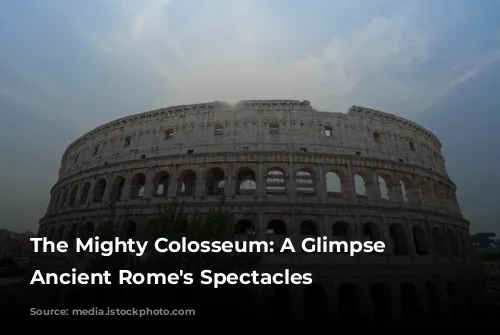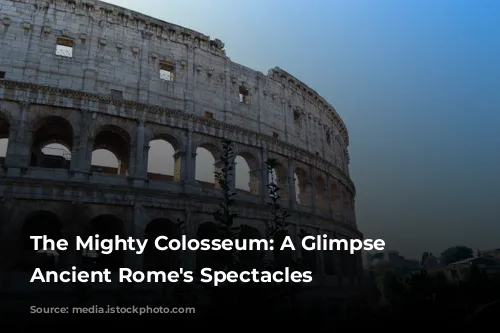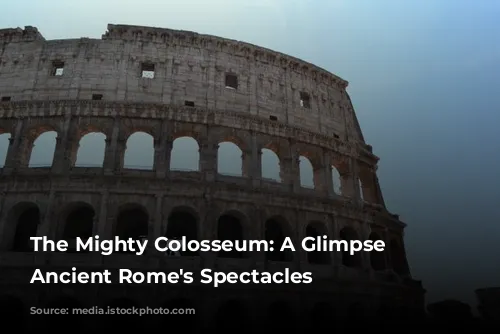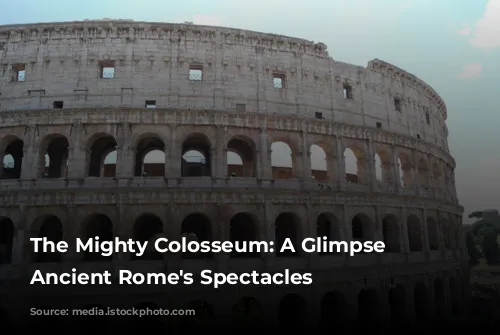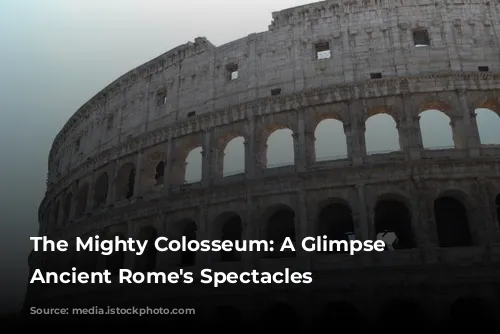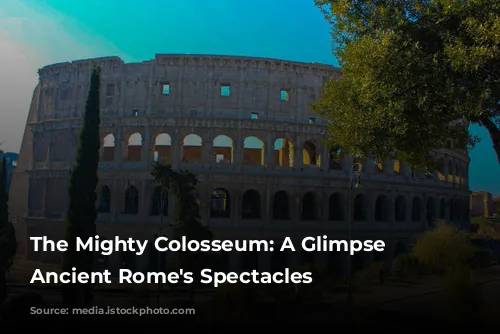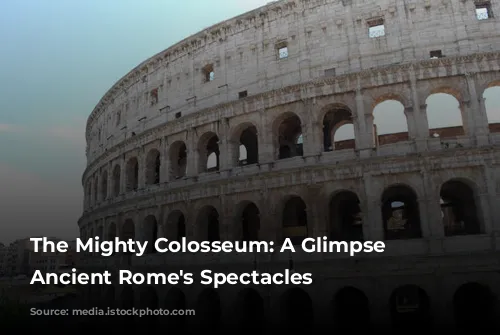The Colosseum, also known as the Flavian Amphitheatre, stands as a testament to the grandeur and might of the Roman Empire. This iconic monument, the largest amphitheatre in the Roman world, is not only a symbol of Rome’s power but also a window into the lives and entertainment of the ancient Romans.
A Monument to Imperial Power
Construction of the Colosseum began under Emperor Vespasian of the Flavia family and was completed by his son, Emperor Titus, in 80 AD. Its inauguration was a grand affair, a 100-day extravaganza featuring thrilling gladiatorial contests, exotic animal hunts, and even naumachiae – elaborate re-enactments of naval battles staged in the arena, which was flooded with water for the occasion.
The name “Colosseum” originates from a prophecy by the Venerable Bede, a medieval monk, who predicted that Rome would stand as long as the Colosseum. It’s thought that the name is derived from the nearby Colossus of Nero, an enormous statue of the emperor that once stood beside the amphitheatre.
Architectural Marvels: A Legacy of Roman Ingenuity
The Colosseum was a masterpiece of Roman engineering. Its elliptical shape, crafted from travertine stone, allowed for maximum seating capacity. The structure boasted four levels, the first three of which featured 80 arches each, adorned with majestic statues.
The Romans’ mastery of the arch played a crucial role in the Colosseum’s construction. This architectural element, also seen in Roman aqueducts, effectively distributes the weight of heavy structures. The Colosseum can be imagined as a series of aqueducts stacked upon each other.
The speed of its construction is astounding – it was built in less than ten years! This accomplishment speaks volumes about the Roman’s organizational skills and mastery of construction techniques.
A Window into Roman Life: From Entertainment to Social Commentary
The Colosseum was more than just an arena; it was a microcosm of Roman society. It could accommodate up to 70,000 spectators seated in tiers that provided unobstructed views of the action below. The seating arrangement mirrored social hierarchy, with the commoners occupying the upper tiers and the elite enjoying front-row seats.
The Colosseum, like modern stadiums, incorporated an ingenious “Velarium” – a massive linen awning supported by a system of ropes, winches, and poles. This retractable roof provided shade for the spectators, operated by a team of 100 sailors from the Imperial fleet who moved it in perfect synchronization to the beat of a drum.
The Gladiators: Heroes and Spectacles
The arena itself, once adorned with a brick and wood floor, has disappeared over time, leaving behind the cellars that housed equipment used for the games. These cellars reveal a fascinating system of lifts and hoists used to bring animals and gladiators onto the arena floor through trapdoors, creating dramatic entrances that stunned the audience.
The shows held in the Colosseum were both symbolic and practical. They served as a link between citizens and their leader, providing a platform for shared experiences and diverting attention from political anxieties.
“Venationes”, contests featuring exotic animals pitted against each other or against humans, were a popular attraction. The “Silvae”, elaborate stage sets depicting forests teeming with animals, offered a less violent form of entertainment.
The gladiators were the stars of the Colosseum. They were recruited from prisoners of war, paupers seeking fame and fortune, and even volunteers. The gladiators fought with various weapons and styles, their duels adding to the drama and excitement of the games.
A Legacy of Blood and Entertainment
Roman spectators were drawn to the brutality and spectacle of the Colosseum’s events. The intensity of these shows is comparable to the modern-day “splatter” film genre. However, the stark reality of blood and gore, the smell of burnt flesh, and the roar of the crowd created a unique atmosphere that is impossible to fully replicate in the modern age.
Despite its violent nature, the Colosseum left an indelible mark on history. It endured centuries of use, becoming a source of building materials for other structures during the Middle Ages, and eventually falling into disuse. Its walls housed a variety of uses, including hospitals, hermits, and even a cemetery.
From Arena to Symbol of Faith
The Colosseum, once a symbol of Roman power, was later adopted as a symbol of Christian martyrdom. Pope Benedict XIV declared it a sacred monument dedicated to the Passion of Christ. A cross placed on a pedestal serves as a reminder of the sufferings of Christian martyrs. This cross is still the starting point for the Stations of the Cross on Good Friday.
The Colosseum, now protected from destruction, stands as a testament to the resilience of history. It is a reminder of the power of ancient Rome, a symbol of Christian faith, and a source of fascination for millions of visitors who continue to marvel at its grandeur and ponder its legacy.
Today, as you stand before the Colosseum, you are not just looking at an ancient ruin, but at a reflection of the past, a timeless reminder of humanity’s enduring fascination with power, spectacle, and the quest for entertainment.
